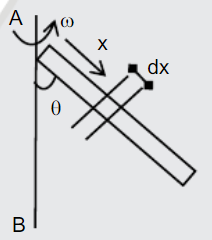A rigid body rotates about a fixed axis with variable angular velocity equal to (a - bt) at time t where a and b are constants. The angle through which it rotates before it comes to rest is
a2b
a22b
a24b
a22b2
The correct Answer is:B
To find the angle through which a rigid body rotates before it comes to rest, given that its angular velocity is a function of time, we can follow these steps:
Step 1: Understand the given angular velocity
The angular velocity ω is given by:
ω(t)=a−bt
where a and b are constants.
Step 2: Determine when the body comes to rest
The body comes to rest when the angular velocity ω becomes zero:
0=a−bt
From this, we can solve for t:
bt=a⟹t=ab
Step 3: Relate angular displacement to angular velocity
The angular displacement θ can be expressed in terms of angular velocity:
dθ=ωdt
Substituting the expression for ω:
dθ=(a−bt)dt
Step 4: Integrate to find the total angle
To find the total angle θ through which the body rotates before coming to rest, we need to integrate dθ from t=0 to t=ab:
θ=∫ab0(a−bt)dt
Step 5: Perform the integration
We can break this integral into two parts:
θ=∫ab0adt−∫ab0btdt
Calculating each integral:
1. The first integral:
∫ab0adt=a(t)ab0=a⋅ab=a2b
2. The second integral:
∫ab0btdt=b(t22)ab0=b⋅12(a2b2)=a22b
Step 6: Combine the results
Now, substituting back into the equation for θ:
θ=a2b−a22b=a22b
Final Result
Thus, the angle through which the rigid body rotates before it comes to rest is:
θ=a22b
---
The angular velocity ω is given by:
ω(t)=a−bt
where a and b are constants.
The body comes to rest when the angular velocity ω becomes zero:
0=a−bt
From this, we can solve for t:
bt=a⟹t=ab
The angular displacement θ can be expressed in terms of angular velocity:
dθ=ωdt
Substituting the expression for ω:
dθ=(a−bt)dt
To find the total angle θ through which the body rotates before coming to rest, we need to integrate dθ from t=0 to t=ab:
θ=∫ab0(a−bt)dt
We can break this integral into two parts:
θ=∫ab0adt−∫ab0btdt
Calculating each integral:
1. The first integral:
∫ab0adt=a(t)ab0=a⋅ab=a2b
2. The second integral:
∫ab0btdt=b(t22)ab0=b⋅12(a2b2)=a22b
Now, substituting back into the equation for θ:
θ=a2b−a22b=a22b
Thus, the angle through which the rigid body rotates before it comes to rest is:
θ=a22b
Topper's Solved these Questions
- PRACTICE PAPERSBook:NCERT FINGERTIPSChapter:PRACTICE PAPERSExercise:Practice Paper 2
Explore 50 Videos
- PRACTICE PAPERSBook:NCERT FINGERTIPSChapter:PRACTICE PAPERSExercise:Practice Paper 3
Explore 50 Videos
- PHYSICAL WORLDBook:NCERT FINGERTIPSChapter:PHYSICAL WORLDExercise:Assertion And Reason
Explore 10 Videos
- SYSTEM OF PARTICLES AND ROTATIONAL MOTIONSBook:NCERT FINGERTIPSChapter:SYSTEM OF PARTICLES AND ROTATIONAL MOTIONSExercise:Assertion And Reason
Explore 15 Videos
Similar Questions
Angular momentum of a rigid body rotating about a fixed Axis with angular velocity →ω
View SolutionA body rotates about a fixed axis wilth an angular acceleration of one radian/second/second. Through what angle does ilt rotate during the time in which its angular velocity increases from 5 rad/s to 15 rad/s.
View Solution
Knowledge Check
A rigid body rotates about a fixed axis with variable angular velocity equal to α−β, at the time t, where α,β are constant. The angle through which it rotates before its stops
Aα22βBα2−β22αCα2−β22βD(α−β)α2For a rotating body about fixed axis ,
Aevery particle moves in a circleBthe linearvelocity is related to angular velocityCBoth (1) and (2) are correctDBoth (1) and (2) are incorrectA rigid body is rotating about an axis. The best way to stop it is applying
Apressure at the turning point.Bupward force at the turning point.Cdownward force at the free end.Dtorque in opposite direction.
A body rotates about a fixed axis with an angular acceleration 1rad/s2 through what angle does it rotates during the time in which its angular velocity increases from 5rad/s to 15rad/s?
View SolutionA solid body starts rotating about a stationary axis with an angular acceleration α=α0cosθ, where α0 is a constant and θ is an angle of rotation from the initial position. Find the angular velocity of the body as a function of θ.
View SolutionA rigid body rotates about a fixed axis with variable angular velocity equal to (a - bt) at time t where a and b are constants. The angle through which it rotates before it comes to rest is
View SolutionA rod is rotating with angular velocity ω about axis AB. Find cosθ.

View SolutionA body rotates about a fixed axis with an angular acceleration of 3rad/s2 The angle rotated by it during the time when its angular velocity increases frm 10 rad/s to 20 rad/s (in radian) is
View Solution